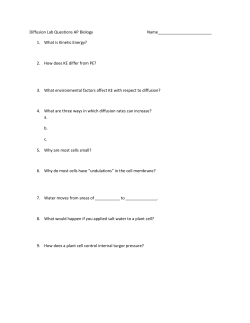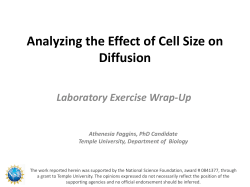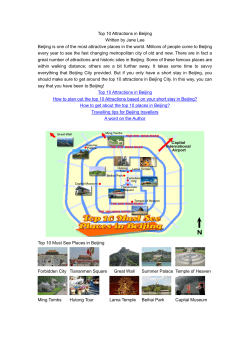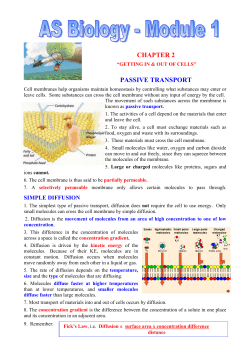
The Method about How to Decide the Geographic
The Method about How to Decide the Geographic Area of Study in Traffic Impact Analyses Wang Li, Liu Xiaoming, Ren Futian Abstract. At present, many countries have adapted Traffic Impact Analysis (TIA) to assess the additional demands for road capacity imposed by new developments. This article discusses when such a traffic impact analysis is needed, and what factors should be considered in the study. The factors relate to the issues involve the geographic area of study; time frame for the phases of the project; non-site traffic; programmed transportation improvements; study methodology; and analyses and recommendations. The main purpose of the study was to put forward diffusion model that decide the geographic area of study, which adapt to different types of developments and different development size. The model is founded according to site traffic dissipative character and based on the principle of synergetic theory, one of System theory. The model found the biggest study area function on the condition of different traffic impact extent around road network of new developments, and then validate this model by how to decide the study area of Beijing Legend science zone. The model makes up for the disadvantage that local officials and highway agencies decide the geographic area of study arbitrarily. The objective of the model is to develop a more efficient and understandable means, by which the traffic impact of a new or expanded development can be identified, coordinate the relationship between land uses and road supply. INTRODUCTION Transportation needs have traditionally derived from land use decisions. One of the major transportation issues addressed in recent years has been the growing concern about transportation infrastructure not being able to keep pace with development. This imbalance between transportation supply and demand has resulted in increased congestion, delay and safety hazards at many locations throughout the big cities of China, such as Beijing. In addition, increasing demand on transportation network results in high noise and exhaustive emission pollution without any planning and regulations. Estimating and taking precautions for several years later network is important as much as for network at the time being. As a result urban transportation planning is the macroscopical planning tool to solve these question, and traffic impact analysis (TIA) are becoming more popular as a microcosmic planning tool compare to urban transportation planning, so that the traffic impacts of new developments can be foreseen and effective mitigation measures can be taken using optimal allocation of available funds. Site impact traffic analysis is a formalized process that attempts to quantity the need for transportation improvements on the roadway network in response to development. The TIA is prepared as part of an application for development approval for a specific proposed land development project, typically during the site plan review process. The primary purpose of the TIA is to identify total roadway improvements needed to ensure that the roadway system will be adequate after completion of the proposed project. The TIA includes a significant amount of data and analysis, generally prepared to meet local standards and local adequate facilities requirements. These include future traffic volumes, anticipated improvement needs and improvement costs, and various measures of development impact. When we develop a procedure for requesting, preparing and reviewing a traffic impact analysis for a proposed development, we need recognize the critical relationship between transportation planning and land use system. In developing the needs of the long-range plans, virtually every metropolitan planning organization relied on Standard Urban Transportation Modeling Structure (SUTMS). Based on SUTMS forecasts, roadway deficiencies are assessed, and roadway capacity are added to the network until the system can better accommodate new development demand. Based on this land use scenario, the model performs trip generation, trip distribution, and network assignment of future travel demand. The result is that forecast roadway capacity deficiencies drive the planning process and put forward programmed transportation improvements. Traffic Impact Analysis, in use for decades in the Western world, has also been recognized in many China Metropolises such as Beijing, Shanghai and Guangzhou, making local agency aware of its advantages as an alternative in solving their chaotic traffic problems. At present, abroad range of local agency requirements and technical procedures for conducting site traffic impact analysis has begun in China. This has led to inconsistencies and disagreements on how such analysis should be performed. During this period of extremely fast growth, it became apparent that a uniform method of assessing the traffic impacts of new development was necessary in China. Traffic studies submitted to the Institute of Urban Transportation Planning were varied in format and methodology and were inconsistent in the types of mitigation measures proposed by the traffic engineer preparing the study. When we develop a procedure for preparing and reviewing a traffic impact analysis for a proposed development, what elements should be addressed? We should consider the key elements required for preparing and reviewing traffic impact analysis for new and expending land developments, the key elements include threshold for study, geographic area of study, study horizon, peak traffic hours and so on. Geographic area of study is the basis of a procedure for preparing a traffic impact analysis, however, the definition of study area varies significantly from locality to locality because of research depth and emphases are different, experience has shown that study area used by most of the localities are arbitrarily--there have no reasonable method which can decide study area objectively. So this study was to put forward which decides the geographic area of study, which adapt to different types of developments and different development size. The model is founded according to site traffic dissipative character and based on the principle of synergetic theory, one of system theory. CURRENT PRACTICES In large part, the contents and extent of a traffic impact analysis depend on the location and size of the proposed development and the conditions prevailing in the surrounding area. An inappropriately large analysis area will unnecessarily increase costs and time for the developer, the study preparer, and the reviewer. In determining how large the study area should be, in many China Metropolises, a general rule is to include in the analysis all roads, ramps and intersections through which peak hour site traffic composes at least 5% of the existing capacity on an intersection approach, or roadway sections on which accident potential or traffic character is expected to be significantly impacted. Traffic that composes more than 5% of a roadway’s capacity can represent a noticeable impact to most drivers. But 5% of peak hour capacity at an intersection approach is tolerance threshold to driver; the tolerance threshold is determined arbitrarily. In addition, in areas where site traffic composes less than 5% of roadway capacity, the intersections adjacent to the site should be analyzed. Usually the rule adapt to local proposed developments. When all known congested locations may be impacted by the proposed development, care should be taken to include in the analysis. The definition of study area has related to the location and size of the proposed development, should start from the distribution and assignment of site traffic, and then study area is determined according to whether the impacts of the proposed project on roadway links and intersections exceed threshold for study. Mode split in China metropolises is far different from the Western world, the proportion of car is very low compare to the Western world, if planners utilize urban transportation planning model to determine study area of single-use that site traffic is relatively small, it is difficult to assure the accuracy of study. In Shanghai, planners make use of outward circle method to determine study area, the method assumes the distribution of site traffic hasn’t direction discrepancy in surrounding road network, namely the discrepancy of travel points have no impact on the distribution of site traffic, centering on site location on the surrounding road network, dividing the surrounding road network into several circles, processing every circle outside, and every link has assigned traffic counts, then study area borderline is defined based on threshold for TIA. The analysis method based on link counts and avoids complicated reconnaissance of surrounding intersections, but the method considered that a lot of intersections have impact on link capacity and link counts, when determining link capacity, the method considered the impact. In addition, the method is used easily and simply. But the method adapted only to the cases study that site traffic is small proportion to traffic zone and recently study and lacking of urban transportation planning model. As to large size development, assigned traffic count in every link is far different from each other because of the direction discrepancy of traffic attraction, and it doesn’t accord with the assumption of the method. DIFFUSION MODEL Diffusion model is founded based on the principle of synergetic theory, synergetic theory regard any research object as system which is made up of many subsystems, these subsystems interact each other by matter and energy and information exchange, the whole system will become one kind of new structure. In the layer of system, the new structure has new properties, and microcosmic subsystems have no the new properties. Synergetic theory study open system, namely how the system evolve into orderly structure from chaos or from another orderly structure. Diffusion model has many properties according to synergetic theory, including: ¯ We regard study area as one system, the system is made up of many subsystems which include links or intersections, and all subsystems in which site traffic is assigned are steady. ¯ The system is non-linear system; at the same time the system has the properties of unbalance or saturation. ¯ Because of the diffusion of site traffic, site traffic break the balance of the original system and make the system far from balance, because the system has the properties of unbalance or saturation, the system can form dissipation structure and then reach new balance at last. ¯ The whole system is open and exchange matter and energy with outside. Figure 1 Site traffic diffusion process Site traffic impact on surrounding road network similar to the process that toxic gas enters into atmosphere. The system is made up of many subsystems; it is open and steady, every unit is equal to one circle, these circles are assigned in study area and are driven diffuse by site traffic impact force, site traffic impact force not only relate to site type and site size but also in direct proportion to size of the proposed development, for example the impact caused by large size of business development is far bigger than scientific research development. The impact caused by site traffic equal to the impact caused by all development units distributed everywhere. Figure 1 indicates the diffusion process of site traffic. The impact is normal distribution of infinite space diffusion equation. The site traffic diffusion model is: C(x,y,z) q exp [ ( y 2 ı 2y z 2 ı z2 ) 2] 2ʌȝı y ı z (1) Where C(x, y, z) = the impact extent on point ( x, y, z ) by the proposed development, the variable has no dimension, x, y, z = the horizontal, vertical and transverse distance between point ( x, y, z ) and development unit, x is defined the diffusion direction of site traffic, q = site traffic impact force, ȝ = the assigned speed of site traffic, ı 2y , ı 2z = the distribution parameter of site traffic distributed in the direction of y and z , both of them are the function of x . The equation Assuming ı y C(x,r) is ız deduced ı ,r2 from the diffusion phenomenon of infinite space. y 2 z 2 then the site traffic diffusion model can be shown as: q exp ( r 2 2ı 2 ) 2ʌȝı 2 According to Robert equation, ı (2) 2kx where k is site traffic diffusion coefficient, and then the site traffic diffusion model can be formulated: C(x,r) q exp ( r 2 4kx) 4ʌxkȝ (3) Where q,ȝ and k is the coefficient which need to be determined. Under normal circumstances, the determination of k relate to the type and size of the proposed development, the determination of q relate to the type of the proposed development and the conditions prevailing in surrounding road network, and the determination of ȝ relate only to surrounding road traffic conditions. In order to estimate site traffic impact by diffusion model, these coefficients need to be assumed in order to simplify computation. Because diffusion coefficient k is only the function of x , according to dimension analysis: k ax Where a is constant, the calibration of a related to the type and size of the site developed, a (0.15, 1). The model can be shown as: C(x,r) q exp ( r 2 4ax 2 ) 4ʌax 2 ȝ (4) q 4ʌaȝR02 ȗQ S C q 4aSȝ (5) Where Q is the impact force which one development unit has impact on surrounding road network. ȗ is diffuse rate of site traffic diffuse outside. The determination of ȗ relate to the type and size of the proposed development, ȗ (0, 1). In order to simplify the model again, assuming the impact force which development unit has impact on links and intersections after site traffic diffuse is equal to the average impact force of development units before site traffic is assigned. C * = the average impact force of development units, ȗQ = the impact force of diffused development unit, S = the development unit area, R0 = the unit circle radius of development unit area. Equation (6) can be deduced from equation (5): q aȝ 4ȗQ (6) Put equation (6) into equation (4), equation (4) can be shown as: C(x,r) ȗQ r2 ( exp ) ʌx 2 4ax 2 (7) The diffusion model considers only site traffic assignment in the direction of x and y , namely z = 0. r 2 y 2 . Where r is the diffusion radius, the value of r is not much too bigger in order to ensure precision, the distribution of r is normal distribution, the range of r is interval a x 2 a x 3 a x 4 a x 5 a x 6 a x , if credibility of r is 0.95 and confidence of r is 2 exp( r 2 4ax ) e 4 2.807 ax 4.193 ax , when 0.0183 . In order to simplify the model again, the model can be shown as: r =4 ax , then C ( x) 1 2S 4 ]Q 4 aSx 3 ]Q | 4 aSx 3 ]Q 4 S x2 ³ ax 4 ax 0 ³ 4 ax ³ 2S 0 e ( r 2 C ( x, r )drdT 4 ax 2 ) dr 0 ³ f 0 (8) exp( r 2 4ax 2 )dr Where C is the average value of C , and C shows the average impact which development units have impacts on point ( x, r ), r (0,4 a x ) In order to compute the biggest impact radius, the model can be shown as: C ]Q 4 S x d2 Cd (9) Where C d is the utmost impact force which the proposed has impact on surrounding road network. xd is the biggest impact radius. The definition of study area depends on local policy and economy as well as the location and type and size of the proposed development. The population and industry size and commerce and finance of the proposed can be regarded as the standard that can measure the economy strength of the proposed development. The impact force can be simulated by way of gravitational field theory; the impact forces of development units can be formulated: Q kP X d2 (10) Where K is diffusion coefficient. P is potential energy, the value of P depends on many factors, such as business area, turnover, employee number, plot ratio and so on, at present it is difficult to find one appropriate expression, assuming that the potential energy of development depends on employee number in order to simplify the expression. The biggest impact radius can be formulated: Xd 3 ]Pa 4 S Cd (11) Where P is employee number pop . When the peak hour level of service without the site developed deteriorates to a LOS D or LOS E as a result of the site being developed, the biggest impact radius x d can be formulated: Xd E3 ]Pa 4 S Cd (12) Where E is modulation parameter, the biggest impact radius corresponding to different site traffic impact can be determined by modulating parameter E , E (0, 1). The utmost impact force C d relate to the location and type and size of the proposed development, C d can be determined by use of transportation planning software, such as Trips and TransCAD, it is determined by comparing the peak hour traffic volumes and level of service with the site developed with without the site developed. CASE STUDY The Fourth Ring Expressway BaiYi Road LEGEND SCIENCE NORTH AREA LEGEND SCIENCE SOUTH AREA QingHua South Road ChengFu Road ZhiChun road N Highway Figure 2 Map of area around Legend science zone In order to verify the effect of diffusion model in practice, the study prepared Traffic impact analysis for Beijing Legend science zone and defined study area by the model. Beijing Legend science zone locate in the central district of Beijing Zhongguancun Science City, the northern part of the project adjacent to the Fourth Ring expressway, the eastern and western and southern part of the project near to city main arterial road, Figure 2 indicates the project position. Xd 3 ȗPa 4 ʌCd Where P = 6000 (according to the project planning in 2010). a = 0.9. The project is mixed-use development, different land uses are combined at a site, such as office and residential uses, conference center and other auxiliary facilities, the position of the site developed correspond to CBD of Beijing Zhongguancun Science City, as a result ] =1, the biggest impact radius can be formulated: Xd 9.13 3 1 Cd Figure 3 indicates the relationship between the biggest impact radius and the utmost impact force: ¯ C d =2.17u 10 4 , X d =152 m . The peak hour LOS B or C without the site developed deteriorates to a LOS E or F as a result of the site developed, the level of service of surrounding road network decline a large amount, and the area is impacted most seriously. ¯ C d =1.66u 10 6 , X d =771 m . By comparing the level of service with the site developed with without the site developed, the peak hour level of service of some links and signalized intersections in surrounding road network deteriorates to a LOS E or F, site traffic have impact on these sections seriously, other links and signalized intersections are impacted also, the peak hour level of service of all links and intersections in the area deteriorates to different extent. ¯ C d = 5.03u 10 7 , X d = 1148 m . By comparing the level of service with the site developed with without the site developed, there have few links and intersections impacted on the borderline of the area, and site traffic impact extent is minor on these sections, only several sections of Chengfu Road in the north of the area are impacted seriously. The Biggest Impact Radius (m) 1.4E+03 1.2E+03 1.0E+03 8.0E+02 6.0E+02 4.0E+02 2.0E+02 0.0E+00 0.0E+00 5.0E-05 1.0E-04 1.5E-04 2.0E-04 2.5E-04 3.0E-04 3.5E-04 Utmost Impact Force Figure 3 The relationship between the biggest impact radius and the utmost impact force The peak hour level of service of all links and intersections can be computed by use of transportation planning software; different utmost impact forces correspond with different area. By comparing the impact extent on all links and intersections in different area according to peak hour level of service, the study area can be determined on the condition that the site traffic has minor impact or have no impact on the borderline of the area. By comparing the three cases, the impact on the borderline of the third case is the smallest; as a result the radius of the biggest study area is 1148 meter. CONCLUSIONS This paper presents a methodology that can be used by localities in determining the study area in which a formal TIA is required for a given development. In developing the methodology, we have employed four major assumptions; i.e., the impact force which development unit has impact on links and intersections after site traffic diffuse is equal to the average impact force of development units before site traffic is assigned; the potential energy of development depends on employee number. Diffusion model not only adapts to different types and different sizes of new development, but also near future and long term traffic impact analysis, especially the model adapts to the locality in which background traffic vary greatly, it is easy to calculate the biggest impact radius by the model, this methodology can make up for the deficiency of present method. It is the author’s expectation that this methodology will be beneficial to localities in developing requirements for TIA submission and encourages additional studies relating to standardization of TIA requirements. But C d is calibrated according to specific site developed, this make the application of the model have somewhat error, and the calibration of C d need to be studied deeply. ACKNOWLEDGEMENTS The authors would like to express their appreciation to the teachers and graduate students from the Transportation Research Center at Beijing University of Technology for the support during field work. A very special thanks to Dr. Yiying Wu for her assistance and technical support in developing the diffusion model. REFERENCES 1. ITE Technical Council Committee 6A-33, A Summary Report. Guidelines for Transportation Impact Assessment of Proposed New Development. ITE Journal, ITE, Institute of Transportation Engineers, Washington, D.C., June 1988, pp. 39-41. 2. Illinois Section of ITE, A Guideline for Local Officials. Traffic Impact/Access Studies. ITE Journal, ITE, Institute of Transportation Engineers, Washington, D.C., July 1992, pp. 44-45. 3. The Transportation Planners Council of the Institute of Transportation Engineers. A Summary of a Proposed Recommended Practice: Traffic Access and Impact Studies for Site Development. ITE Journal, ITE, Institute of Transportation Engineers, Washington, D.C., August 1988, pp. 17-24. 4. SoumyaS.Dey etc. Traffic Impact Analysis and Impact Fees in State Departments of Transportation. ITE Journal, ITE, Institute of Transportation Engineers, Washington, D.C., May 1994, pp. 39-44. 5. Site Impact Traffic Assessment—problems and solution. Published by the American Society of Civil Engineers, New York, June 1992. 6. Stover, V. G., Koepke, F. J. Transportation and Land Development. Institute of Transportation Engineers, Washington, D.C., 1988, pp. 226-235. 7. Barton-Aschman Associates, Inc. Applicant's Guide: Transportation Impact Studies for Proposed development. Dallas, Texas, September 1990. 8. McKenna Associates Inc and the WBDC Group etc. Evaluating Traffic Impact Studies-A Recommended Practice for Michigan Communities. Tri-County Regional Planning Commission, Lansing, Michigan, 1994. 9. Sheffi, Y. Urban Transportation Networks: Equilibrium Analysis with Mathematical Programming Methods. Prentice Hall, Englewood Cliffs, N.J. 10. Transportation Research Board. Highway Capacity Manual. National Research Council, Washington, D.C., USA, 1985. 11. Transportation Research Board. Highway Capacity Manual. National Research Council, Washington, D.C., USA, 2000. 12. Zhaoyi Huang, Xiang Huang, Kefei Yan. The Research on Defining the Study Area in Traffic Impact Analysis. Proceedings of the conference sponsored by the China Urban Transportation Planning Council, Beijing, China, 1999, pp. 212-218. 13. Dongsheng Miao. The Principle of System Science. Published by Renmin University of China, Beijing, China, 1990, pp. 345-350. Author’s Information: Wang Li Traffic Engineer Transportation Research Center Beijing Polytechnic University Beijing, 100022 China Tel: +8610-67392082 Fax: +8610-67391532 Email: Lwang@bjpu.edu.cn Liu Xiaoming Professor Transportation Research Center Beijing Polytechnic University Beijing, 100022 China Tel: +8610-67392082 Fax: +8610-67391532 Email: Lxming@bjpu.edu.cn Or Liuxm@bjpu.edu.cn Ren Futian Professor Transportation Research Center Beijing Polytechnic University Beijing, 100022 China Tel: +8610-67392082 Fax: +8610-67391532 Email: renfutian@bjpu.edu.cn
© Copyright 2025





















